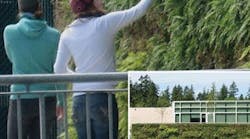Have you ever thought about taking landscaping principles and applying them to your facade?
Green walls use modular tiles or cabling to support plant life on your envelope, providing thermal, ecological, and aesthetic benefits. Growing plants vertically may sound difficult, but you don’t need a green thumb to construct a living facade.
Green Facades and Living Walls
Green walls offer two variations – green facades and living walls.
“Green facades provide a mechanism for climbing plants that is independent of the wall, such as cable, trellis, or grid-based systems,” explains Steven Peck, founder and president of Green Roofs for Healthy Cities.
Living walls incorporate vegetation into your existing architecture. Modular units that contain growing medium (soil) or hydroponics are integrated into the envelope.
Green walls are suited to a variety of facades, but structural load capacity and irrigation needs must be met.
“Installation depends on where you are going to put it, to what degree a wall needs to be prepared, and what kind of mechanics are already in place,” explains Doug Hamming, a principal for Stantec Architecture, which worked on a green wall at the Vancouver Aquarium.
Your region’s weather and building orientation will also shape a green wall project, says Peck. Green facades fare better in cool climates, while living walls need consistent temperatures.
Select the Right Plants
Plant selection is of utmost importance.
Regional species are best because they are suited to your location. “You’re putting these plants into an artificial climate with a thin soil system – they need to be able to handle that,” advises Hamming.
You should also pick a variety of plants that will thrive throughout seasonal changes. Grasses, climbing vines, flowers, and food-bearing plants can all be used, depending on the scale of the project and your climate.
More on this topic: How a Green Wall Gave Life to this Parking Garage
Select the wrong plants and they either won’t survive or will inflict unintended consequences. Ivy, for example, finds its way into cracks and can push bricks out of your facade. “Non-invasive species are a must,” says Hamming. “Invasive species are destructive for the local ecosystem and choke out important regional plants.”
All green walls need an irrigation system. Living architecture is water- and maintenance-intensive, but so is any landscaping. Because of gravity, moisture drains quickly and plants can easily perish if neglected. Plan on basic trimming and pruning as well.
Vegetation in Vancouver
The green envelope was inspired by the aquarium’s educational mission and LEED certification. “The aquarium sits in one of the largest urban parks in North America,” Hamming explains. “For a recent revitalization, we had to increase the property’s footprint into the park. The green wall was a strategy to balance the expansion and respect the existing site.”
The project cost $100 per square foot to install and houses eight plant species. The aquarium also took advantage of its reclaimed water system and slashed expenses by redirecting rainwater to the wall.
“Living walls and green facades must be carefully planned and maintained,” advises Peck. “They are not a plug-and-play technology.”
The living wall has been deemed a success with few complications. The public responds positively to the space and respects the foliage. The greatest challenge has been ensuring that complete maintenance knowledge is passed on to new hires.
Take Your Chances
While enthusiasm peppers conversations about living architecture, understand that formal standards and long-term studies have yet to be developed. “Living walls and green facades must be carefully planned and maintained,” advises Peck. “They are not a plug-and-play technology.”
As a thoughtful strategy, however, green walls create a compelling architectural feature, boost your mechanical systems, and contribute to environmental responsibility.
Jennie Morton was an assistant editor for BUILDINGS.
Two hand-picked articles to read next:


